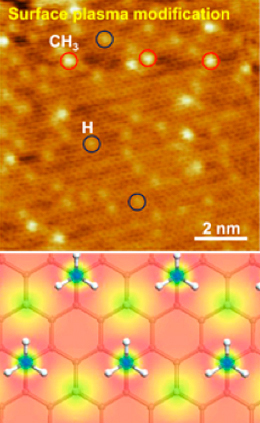可逆的気相反応を用いてグラフェンの特性を調節する
Tuning the properties of graphene using a reversible gas-phase reaction
2012年11月23日 NPG Asia Materials 4, e11 (2012) doi:10.1038/am.2012.58
グラフェン:温和な反応ルート

グラフェン(原子1個分の厚さのグラファイトシート)の発見は、科学技術界に大いなる熱意をもたらした。興味深くかつ有望な特性を持つことから「ワンダー・マテリアル」と称されるこのグラフェンは今、電子デバイスからバイオメディカルデバイスに至るまで、さまざまな応用分野で重要な役割を果たそうとしている。しかしながら、グラフェンの特性調節は依然として困難で、例えば、グラフェン表面にメチル(–CH3)基を結合させると電子構造のバンドギャップを拡大することが可能だが、こうした官能基を付けすぎるとグラフェンシートの性能は損なわれてしまう。このたび、そうした問題を克服できる方法が、北京大学(中国)のXuefeng Guoをはじめとする研究チームによって報告された。研究チームは、グラフェンとメタンプラズマの温和な気相反応を通して、メチル基と水素原子を制御性よく可逆的にグラフェンシートに導入したのである。今回、2種類の官能基をうまく導入したこの方法は、将来的にセンシングやオプトエレクトロニクスデバイス向けの先端材料の作製を可能にするかもしれない。
Graphene: Taking the mild route
The discovery of graphene — a sheet of graphite that is only one atom thick — has sparked much enthusiasm in the science and technology communities. Dubbed ‘wonder material’ owing to its intriguing and promising properties, graphene is poised to play a crucial role in applications that range from electronic to biomedical devices; however, tuning its properties remains challenging. Grafting methyl (–CH3) groups on its surface, for example, can open a band gap in its electronic structure, but too many functional groups will damage the original sheet. Xuefeng Guo and co-workers from Peking University have now described a route that circumvents previous issues. Through a mild gas-phase reaction between graphene and methane plasma, the researchers incorporated both methyl groups and hydrogen atoms to the sheet in a controlled, and reversible, manner. This process, which introduces two functional groups, may enable in future the preparation of advanced materials for applications in sensing or optoelectronic devices.

